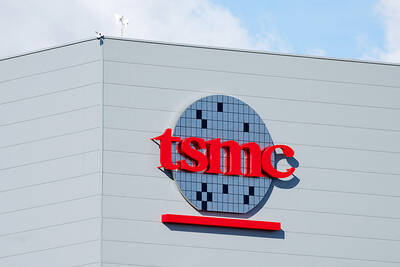Japan’s trade deficit widened last month, as the nation’s import bill continued to rocket upward, fueled by a historic slide in the yen that has already helped push the economy back into reverse.
The trade gap grew to ¥2.16 trillion (US$15.5 billion) from ¥2.09 trillion, the Japanese Ministry of Finance reported yesterday.
The balance has now been negative for 15 straight months, the longest streak since 2015. Economists had expected a ¥1.62 trillion deficit.

Photo: EPA-EFE
Imports grew at the fastest pace since 1980 as the yen inflated already elevated commodity prices. The 53.5 percent gain was led by buying of crude oil, liquid natural gas and coal. Analysts had expected a 50 percent rise in inbound shipments.
Exports gained 25.3 percent driven by vehicles and semiconductor parts, for a slightly weaker increase than forecast by economists.
The prolonged trade deficit reflects Japan’s still fragile recovery from the COVID-19 pandemic, and came after the nation’s economy unexpectedly shrank in the third quarter, weighed down in part by the impact of the tumbling currency.
The streak of red trade ink is likely to keep feeding back into yen weakness, although the currency has made some gains this month.
The trade data showed that the average exchange rate was ¥145.09 to the US dollar, 30 percent weaker than a year earlier. The yen neared ¥152 per US dollar at one point last month, hitting a fresh 32-year low.
Following its first intervention to support the yen since 1998 in September, the Japanese government continued to step into markets again last month.
The trade outlook is further clouded by the prospect of a global slowdown as the impact of higher interest rates overseas weighs on demand.
For now, exports continue to rack up solid gains, with shipments to the US rising 36.5 percent from a year earlier to outstrip the total to mainland China.
Exports to China grew 7.7 percent for the smallest increase since June. Outbound shipments to Europe gained 28.1 percent.
Domestically, the weak yen has driven up energy costs and inflation rates, affecting Japanese households and companies. The nationwide core consumer price index hit 3 percent in September for the first time in more than three decades excluding the impact of tax hikes.
This month’s figure, which is to be announced today, is projected to be even higher at 3.5 percent.
To ease the hit of higher prices on consumption, Japanese Prime Minister Fumio Kishida last month ordered an economic stimulus package that includes aid to reduce energy costs and cash handouts for childcare.
His Cabinet has approved an extra budget of ¥29.1 trillion to partly fund the measures.

Taiwan Semiconductor Manufacturing Co (TSMC, 台積電) secured a record 70.2 percent share of the global foundry business in the second quarter, up from 67.6 percent the previous quarter, and continued widening its lead over second-placed Samsung Electronics Co, TrendForce Corp (集邦科技) said on Monday. TSMC posted US$30.24 billion in sales in the April-to-June period, up 18.5 percent from the previous quarter, driven by major smartphone customers entering their ramp-up cycle and robust demand for artificial intelligence chips, laptops and PCs, which boosted wafer shipments and average selling prices, TrendForce said in a report. Samsung’s sales also grew in the second quarter, up

LIMITED IMPACT: Investor confidence was likely sustained by its relatively small exposure to the Chinese market, as only less advanced chips are made in Nanjing Taiwan Semiconductor Manufacturing Co (TSMC, 台積電) saw its stock price close steady yesterday in a sign that the loss of the validated end user (VEU) status for its Nanjing, China, fab should have a mild impact on the world’s biggest contract chipmaker financially and technologically. Media reports about the waiver loss sent TSMC down 1.29 percent during the early trading session yesterday, but the stock soon regained strength and ended at NT$1,160, unchanged from Tuesday. Investors’ confidence in TSMC was likely built on its relatively small exposure to the Chinese market, as Chinese customers contributed about 9 percent to TSMC’s revenue last

With this year’s Semicon Taiwan trade show set to kick off on Wednesday, market attention has turned to the mass production of advanced packaging technologies and capacity expansion in Taiwan and the US. With traditional scaling reaching physical limits, heterogeneous integration and packaging technologies have emerged as key solutions. Surging demand for artificial intelligence (AI), high-performance computing (HPC) and high-bandwidth memory (HBM) chips has put technologies such as chip-on-wafer-on-substrate (CoWoS), integrated fan-out (InFO), system on integrated chips (SoIC), 3D IC and fan-out panel-level packaging (FOPLP) at the center of semiconductor innovation, making them a major focus at this year’s trade show, according

DEBUT: The trade show is to feature 17 national pavilions, a new high for the event, including from Canada, Costa Rica, Lithuania, Sweden and Vietnam for the first time The Semicon Taiwan trade show, which opens on Wednesday, is expected to see a new high in the number of exhibitors and visitors from around the world, said its organizer, SEMI, which has described the annual event as the “Olympics of the semiconductor industry.” SEMI, which represents companies in the electronics manufacturing and design supply chain, and touts the annual exhibition as the most influential semiconductor trade show in the world, said more than 1,200 enterprises from 56 countries are to showcase their innovations across more than 4,100 booths, and that the event could attract 100,000 visitors. This year’s event features 17